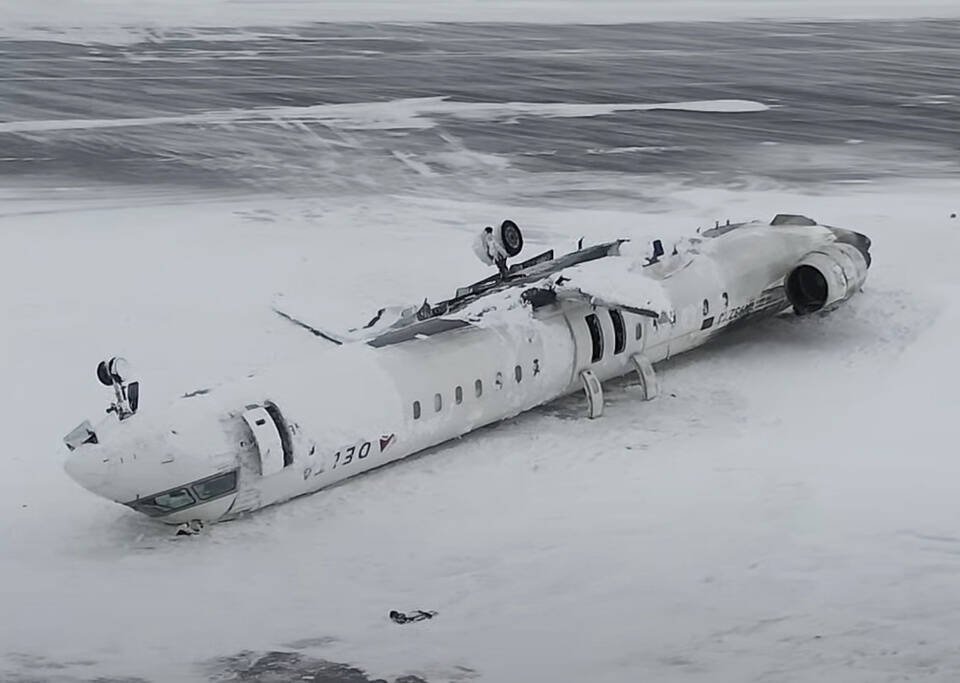After a spate of air travel-related fatalities beginning with the tragic midair collision of an American Eagle Flight and an Army Black Hawk helicopter just outside of Reagan National Airport in Arlington, Virginia, earlier this month, 80 people are expected to miraculously survive a crash landing in Canada on Monday.
Delta Connection Flight 4819 carrying 76 passengers and four crew members from Minneapolis–Saint Paul International Airport flipped over while attending to land at Toronto’s Pearson Airport in windy conditions, but all on board survived.
On Tuesday’s show, Megyn was joined by aviation experts Whiz Buckley and Greg Feith to discuss what likely caused the shocking crash and why there were no fatalities.
What Went Wrong?
Videos on social media show what happened as the Delta regional jet descended onto the snowy tarmac in Toronto and turned over before erupting in flames. Passengers on board also took footage of themselves strapped into their seats and hanging upside down. While some suffered injuries in the crash, all are expected to survive.
Initial reports suggested weather – specifically, strong crosswinds and icy conditions – may have played a role, but officials have tried to downplay the threat. Buckley, a retired Navy fighter pilot, wasn’t so sure. “Landing on runway 23, the winds were… about 40 degrees off the nose… in really gusty condition,” he explained. “It looks like this airplane didn’t really have too much of a flare, which is when you get close into the runway we pull… back on the throttles and kind of do that nice, what we as Navy pilots would say, Air Force landing.”
But this landing was anything but nice. “This landing was hard,” Buckley continued. “And it looks like it sheared off the right main landing gear, took the wing with it, and then the only wing that was left – the left wing – still producing lift, so they kind of cork screw and roll down the runway.”
Buckley said there is also something to be learned from the data available thus far. “Landing an F18 aboard an aircraft carrier, our average rate of descent is about 8,800 feet per minute, and I think the last flight tracker data that I saw for this [regional jet] was about 1,100 feet per minute,” he explained. “So that RJ came down a lot faster and harder than I would have landed aboard the boat.”
The Investigation
Feith, a former senior air safety investigator with the National Transportation Safety Board (NTSB), said the jet was traveling almost twice as fast as it should have been. “I’m going to be interested to know from the flight data recorder… how many G-forces were experienced on that landing… and whether or not that the actual nose of the airplane was cocked off center,” he noted.
“A lot of times in these crosswinds… you’ll typically add a ‘gust factor’ – you’ll actually increase your speed by half the ‘gust factor’ to give you more controlability,” Feith added. All of these things are going to have to be dissected by the investigators.”
While Canadian authorities will be taking the lead on the investigation, Feith said the NTSB will be part of it as well. One of the things that will be looked at is the experience of the pilots and who was flying at the time of the crash.
While Feith said autopilot accounts for about 90 percent of the flying time in these types of flights, takeoffs and landings are a different story. “Typically, in this type of airplane, takeoffs and landings are done by one of the two pilots manually. You’re not using an autopilot,” he noted. “You’ll use some navigation guidance on some of the airplanes, but… you’ll typically have one of the pilots landing the airplane manually and there’s nothing wrong with that – even under these conditions.”
What Went Right
While there is much to be learned about what went wrong, Buckley said it is miraculous that this avoided being a tragedy. “Thankfully this mishap was on landing so that aircraft wasn’t packed full of fuel,” he noted. “This could be a whole different story if this happened on takeoff or if they were coming into the landing full of fuel for whatever reason.”
He also credited the emergency responders for their quick action. “The crash rescue folks are literally sitting in different alert positions on these airfields… waiting for something like this to happen,” Buckley continued. “They were on that crash almost immediately and they were foaming down the aircraft to protect against the fire.”
The seatbelts, seats, and structure of the plane itself also did their jobs, but it still defies the odds. “This literally has got to come to a higher power,” Buckley concluded. “Because as I saw this mishap occur and then I saw the video, I’m absolutely stunned that more people didn’t get hurt.”
You can check out Megyn’s full interview with Buckley and Feith by tuning in to episode 1,009 on YouTube, Apple Podcasts, or wherever you like to listen. And don’t forget that you can catch The Megyn Kelly Show live on SiriusXM’s Triumph (channel 111) weekdays from 12pm to 2pm ET.


